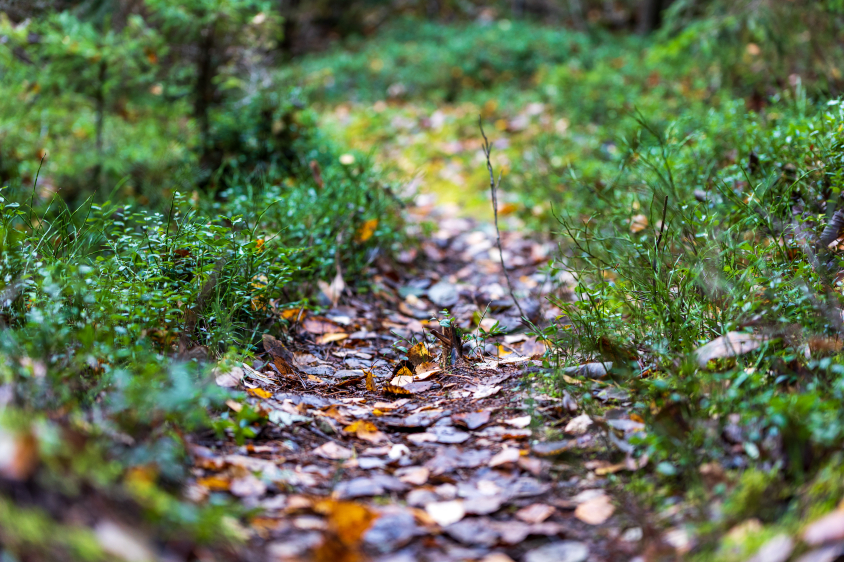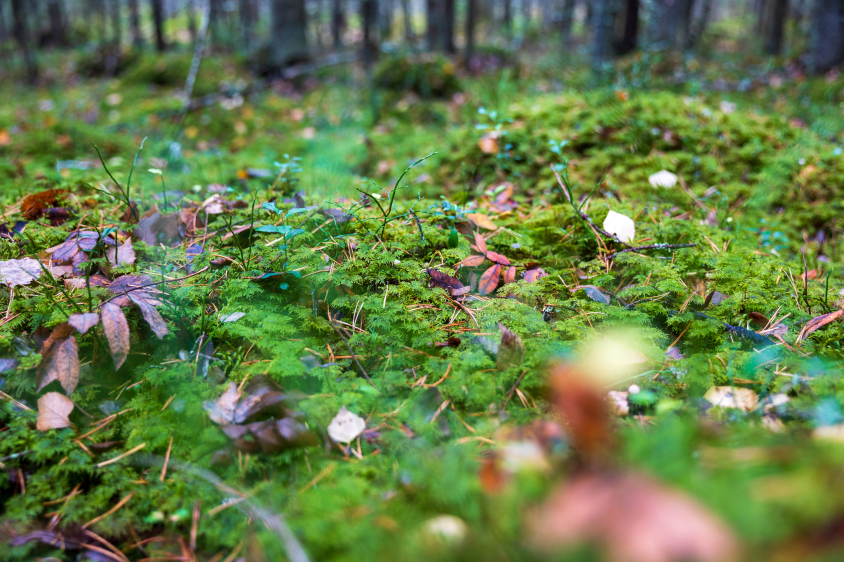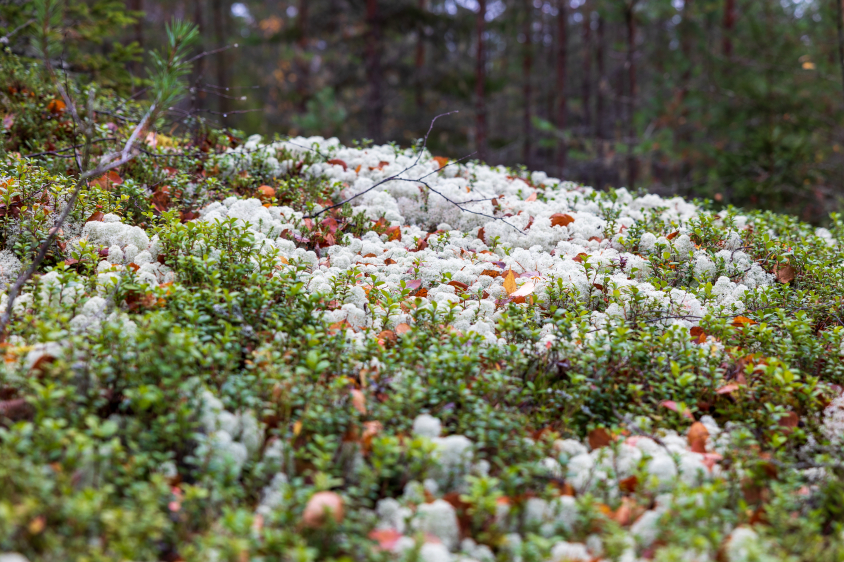1.Breathing/presence exercise: enjoy the moment
A moment of mindful presence helps to break away from the hectic tempo of everyday life. Our attention is then more easily drawn inwards. Through the experience of being, we can also feel more easily part of nature, of the natural cycle and its big picture.
Stop for a moment before setting off on the nature trail. Stand balanced so that you can feel the ground under your feet. Close your eyes and turn your attention inwards. Focus on your breathing. Feel the air flowing in through your nose and out through your mouth. Breathe with a natural rhythm. Let yourself relax. Imagine you are a tree with its roots firmly planted into the ground.
With each exhale, you release your accumulated burden through your feet towards the roots and the ground. With each inhale, the earth nourishes the tree roots and releases energy through your feet into your body. Breathe like this for a moment.
Next, bring your attention to your whole body. How does your body feel right now? Enjoy the moment.
2.Change of perspective exercise: focus your gaze
Changing perspectives help you to look at things in different proportions and from different angles.
Move forward in nature. At first, just focus your gaze close up (on your feet). You find that you can't really navigate forward when you can't see where you're going. You can even lose your sense of direction if you only proceed in this way.
Next, focus your gaze solely on the distance, as far away as possible. Looking far away, you can't see if you're tripping over rocks or tree roots, but you can see which way you're going. You'll soon realise that you may need both of these perspectives to make the best progress.
Ask yourself if there are any stumbling blocks in your life as you navigate your way forward in life. Perhaps you should look at a more diverse range of perspectives?
3.The backwards exercise: a reverse perspective
Some indigenous communities have a person who has taken on the role of a clown, who awakens people with their appearance and actions. They may have their clothes on inside out and they might do things backwards. Laughing and letting go through this can also help you deal with the challenges and threats of everyday life.
According to Finnish folklore, the forest has been considered to be frightening, as it was believed to be able to cast a spell on people. When the forest enchants someone, they are “covered by the forest”, in the world beyond. The so-called forest cover was a kind of inverted world, to escape from which you had to do something backwards to escape, like walking backwards or putting their clothes on inside out.
Do things backwards and the wrong way round. Try walking backwards in nature. However, be careful not to trip and fall. As you walk backwards, you find that you are looking into the past while moving towards the future. What thoughts does it evoke in you? At the end of the exercise, you can reflect on how you felt.
4.Open senses exercise: listen to your body
When you recognise the sensations, you can enjoy the uniqueness of the moment in full. Focusing on them also helps you to be mindfully present. Mind skills include paying attention and making observations. In nature, your senses are sensitised and alerted.
Walk in nature without talking and by consciously feeling with your different senses. Sense your own body. How you walk: how is your walking rhythm, how the soles of your feet feel against the ground and how is your posture. How does the wind feel on your skin? What does nature smell like? Does any smell seem stronger than the others? What sounds can you hear around you? Which sounds do you hear the loudest, and which the quietest? What do you see (what colours and shapes)?
Finally, what feelings (e.g. joy, curiosity, excitement) did these sensory exercises evoke in you?
5.Frog exercise: warm up your muscles
Do this exercise by listening to your body. The purpose of the exercise is to warm up your muscles and stretch them at the same time. If the movement is not suitable for your knees, for example, try to adapt it or skip this exercise.
Stand with your legs slightly apart and turn your toes slightly outwards from the midline of your torso. Slowly squat down as deep as you can, keeping your knees in line with your toes. Brace your hands against the ground. Look forward and straighten your back. Then relax your neck and let your head come down. Close your eyes and listen to your breathing. Stay in this position as long as you want. Open your eyes and straighten your legs (your knees may be slightly bent), but remain in a forward bend with your head down. Explore what the world looks like from this perspective. Then slowly roll up with your back rounded.
Next, try doing this by doing it 10 to 15 times up and down like a frog, but at a faster pace. Continue at your own pace.
6.Nature's eye exercise: you are part of nature
According to our ancient folklore, everything has a soul or spirit. From this point of view, you can get the idea that when you sense nature and the elements, they sense you. Keep this image in mind when you start performing the following exercise.
Start the exercise by standing firmly and feeling the ground under your feet. Imagine that you are part of this nature and landscape. Look at nature and the landscape with gentle eyes. What feelings does it evoke in you? Next, change your perspective so that nature is looking at you. How does it see you? What strengths does it see in you? Imagine that nature is also looking at you as gently as you looked at it. Consider ideas on how you could show kindness to nature and yourself in other ways. Offer yourself words of wisdom and compassion.
You can also use humour during the exercise. Humour is a good way to break the boundaries of thought patterns.
7.Worry release exercise: free yourself from worries
Unforeseen events sometimes occur in the natural cycle, and nature's ability to adapt is what allows it to cope. Nor can we always control the course of our lives, no matter how much we plan and prepare for the future. Accepting the better and worse helps you adapt to life's adventures.
The body accumulates various worries and can get bogged down by them. Notice where you feel discomfort in your body. Release tension in your body by shaking it. Shake, tremble and bounce. In your mind's eye, imagine your worries falling from your shoulders in the same way that leaves fall from the trees in autumn.
Imagine dropping a worry on a rock or stump and watching it. What does this worry tell you and what is its purpose? Where do you go from here? Do you take it with you or leave it on the rock or stump where you dropped it?
8. Gratitude exercise: something to be thankful for
Feelings of gratitude increase your zest for and satisfaction with life, and give you faith in the future.
Think about the things you are grateful for. Gratitude can be about everyday things. For example, we can be grateful that nature provides us with the conditions for life. Gratitude can also be about very small things.
As themes start to come to mind, you can start to walk slowly forward in nature, with each step symbolizing a theme of gratitude that comes to mind.
9.Forest exercise: get your body moving
Repeatedly do arm rotations, shoulder rotations, wrist rotations, torso rotations, straddle jumps and deep squats. Jump and leap across the path in different ways.
Do push-ups against a rock or a stump. Keep your body straight. You can also try doing this against a sturdy upright tree trunk, where you sort of fall against the tree trunk about a metre from the trunk. You can lean against the trunk at a slight angle. In this case, you should do every other push-up diagonally to the right and left. This creates a slight rotational movement in your upper body. Try what feels good for your body.
Take a step and get up on a rock or stump with the other foot. Lift the opposite knee up, straighten the hips. Keep a good posture and look at the horizon. You can also balance with your arms. Do both sides.
Lean your hands against a rock or a tree trunk on the ground, as if in a push-up position. Alternate lifting your legs up towards the sky. This movement is felt in the buttocks. Choose a suitable planking spot and exercise your abs.
10.The power tree: try tree meditation
In folklore, the sacredness of the landscape is expressed, for example, through individual trees. Large, important and powerful trees have been considered to be particularly sacred. These have been considered, among other things, to be world trees, located at the centre of the world.
Find a tree that feels like it's calling you. When you find the right tree, get to know it as if it were your new acquaintance. What are its external characteristics? Next, lean on the tree and breathe with it. Close your eyes. How does a tree trunk feel against your body? Does the tree sway in the wind and how does it feel? What kind of message of silence could the tree have for you? Think about what in that tree represents the thing that gives you the most strength? How could you increase this in your daily life?
Finally, try the following tree meditation: With each inhale, imagine the tree giving you good energy, and with each exhale, imagine bad energy (such as negative thoughts) sliding into the tree and through its roots into the ground. The earth converts the bad energy back to neutral, so you are part of a continuous cycle.
11.In the arms of the forest exercise: the mythical forest
For many people today, a forest is just an ordinary forest. Delving deeper into the mythical history of the forest reveals another dimension through which it can also be approached.
In folklore, the forest is the sacred expression of the landscape and the forest has been greatly revered. The Finnish word for forest, metsä, has once meant far, edge, and border. Crossing this border has required various rituals to show respect and to ask permission to enter the forest. There are places in the forest that are perceived as particularly being important and empowering. They are often our favourite places too. In some places, the sacredness of the forest is particularly evident. Since time immemorial, offerings have been brought to these in the hope of maintaining good reciprocal relations with the forces of the forest.
The nature trail runs through the arms of the forest. How do you experience the forest? Is the forest your hiding place for relaxation? Note its protective and soothing effect. What is your favourite spot in the forest? What kind of places empower you best? How do you experience the sacredness of the forest manifesting itself to you? How could you acknowledge the forest when you enter it?
12.Good in the moment exercise: focus on successes
Through positive thinking, it is possible to gain strength and energy for oneself by focusing on the positive aspects of life. So it's about where we focus our attention and what kind of experiences we gather. Good things carry us forward in our everyday moments.
Walk calmly forward and focus on the good things that have happened to you in your life. What successes, achievements and moments of happiness have you encountered? How did they feel? And what skill or ability made it possible for a good thing to happen?
Consider what kind of state of mind helps a good thing happen. Finally, you can think about the future, what good things could it bring? How can you ensure that your thoughts, feelings and actions support this future moment of success?


![Logo [Virtain kaupunki]](client/virrat/images/logo.png)
















